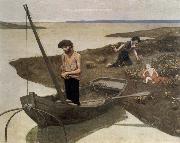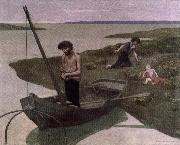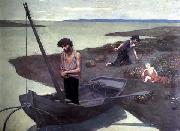Wholesale Oil Painting No Minimum |
|||||||||||
|
|
|||||||||||

|
|||||||||||
|
|
|
||||||||
Pierre Puvis de Chavannes1824-1898 French Pierre Puvis de Chavannes Art Galleries Born in Lyons on Dec. 14, 1824, Pierre Puvis de Chavannes belonged to the generation of Gustave Courbet and ??douard Manet, and he was fully aware of their revolutionary achievements. Nevertheless, he was drawn to a more traditional and conservative style. From his first involvement with art, which began after a trip to Italy and which interrupted his intention to follow the engineering profession that his father practiced, Puvis pursued his career within the scope of academic classicism and the Salon. Even in this chosen arena, however, he was rejected, particularly during the 1850s. But he gradually won acceptance. By the 1880s he was an established figure in the Salons, and by the 1890s he was their acknowledged master. In both personal and artistic ways Puvis career was closely linked with the avant-grade. In the years of his growing public recognition, when he began to serve on Salon juries, he was consistently sympathetic to the work of younger, more radical artists. Later, as president of the Societe Nationale des Beaux-Arts - the new Salon, as it was called - he was able to exert even more of a liberalizing influence on the important annual exhibitions. Puvis sympathy to new and radical artistic directions was reflected in his own painting. Superficially he was a classicist, but his personal interpretation of that style was unconventional. His subject matter - religious themes, allegories, mythologies, and historical events - was clearly in keeping with the academic tradition. But his style eclipsed his outdated subjects: he characteristically worked with broad, simple compositions, and he resisted the dry photographic realism which had begun to typify academic painting about the end of the century. In addition, the space and figures in his paintings inclined toward flatness, calling attention to the surface on which the images were depicted. These qualities gave his work a modern, abstract look and distinguished it from the sterile tradition to which it might otherwise have been linked. Along with their modern, formal properties, Puvis paintings exhibited a serene and poetic range of feeling. His figures frequently seem to be wrapped in an aura of ritualistic mystery, as though they belong in a private world of dreams or visions. Yet these feelings invariably seem fresh and sincere. This combination of form and feeling deeply appealed to certain avant-garde artists of the 1880s and 1890s. Although Puvis claimed he was neither radical nor revolutionary, he was admired by the symbolist poets, writers, and painters - including Paul Gauguin and Maurice Denis - and he influenced the neoimpressionist painter Georges Seurat. During his mature career Puvis executed many mural paintings. In Paris he did the Life of St. Genevieve (1874-1878) in the Panth??on and Science, Art, and Letters (1880s) in the Sorbonne. In Lyons he executed the Sacred Grove, the Antique Vision, and Christian Inspiration (1880s) in the Mus??e des Beaux-Arts. He painted Pastoral Poetry (1895-1898) in the Boston Public Library. These commissions reflect the high esteem with which Puvis was regarded during his own lifetime. Among his most celebrated oil paintings are Hope (1872) and the Poor Fisherman (1881). He died in Paris on Oct. 10, 1898. |
||||||||
|
|
||||||||
The Poor Fisherman
The Poor Fisherman Painting ID:: 10944 |
1881.
Salon of 1881.
5' 1" x 6' 3 3/4" ( 155 x 192.5 cm ). 1881. Salon of 1881. 5' 1" x 6' 3 3/4" ( 155 x 192.5 cm ). |
|||||||
|
|
||||||||
Pierre Puvis de Chavannes1824-1898 French Pierre Puvis de Chavannes Art Galleries Born in Lyons on Dec. 14, 1824, Pierre Puvis de Chavannes belonged to the generation of Gustave Courbet and ??douard Manet, and he was fully aware of their revolutionary achievements. Nevertheless, he was drawn to a more traditional and conservative style. From his first involvement with art, which began after a trip to Italy and which interrupted his intention to follow the engineering profession that his father practiced, Puvis pursued his career within the scope of academic classicism and the Salon. Even in this chosen arena, however, he was rejected, particularly during the 1850s. But he gradually won acceptance. By the 1880s he was an established figure in the Salons, and by the 1890s he was their acknowledged master. In both personal and artistic ways Puvis career was closely linked with the avant-grade. In the years of his growing public recognition, when he began to serve on Salon juries, he was consistently sympathetic to the work of younger, more radical artists. Later, as president of the Societe Nationale des Beaux-Arts - the new Salon, as it was called - he was able to exert even more of a liberalizing influence on the important annual exhibitions. Puvis sympathy to new and radical artistic directions was reflected in his own painting. Superficially he was a classicist, but his personal interpretation of that style was unconventional. His subject matter - religious themes, allegories, mythologies, and historical events - was clearly in keeping with the academic tradition. But his style eclipsed his outdated subjects: he characteristically worked with broad, simple compositions, and he resisted the dry photographic realism which had begun to typify academic painting about the end of the century. In addition, the space and figures in his paintings inclined toward flatness, calling attention to the surface on which the images were depicted. These qualities gave his work a modern, abstract look and distinguished it from the sterile tradition to which it might otherwise have been linked. Along with their modern, formal properties, Puvis paintings exhibited a serene and poetic range of feeling. His figures frequently seem to be wrapped in an aura of ritualistic mystery, as though they belong in a private world of dreams or visions. Yet these feelings invariably seem fresh and sincere. This combination of form and feeling deeply appealed to certain avant-garde artists of the 1880s and 1890s. Although Puvis claimed he was neither radical nor revolutionary, he was admired by the symbolist poets, writers, and painters - including Paul Gauguin and Maurice Denis - and he influenced the neoimpressionist painter Georges Seurat. During his mature career Puvis executed many mural paintings. In Paris he did the Life of St. Genevieve (1874-1878) in the Panth??on and Science, Art, and Letters (1880s) in the Sorbonne. In Lyons he executed the Sacred Grove, the Antique Vision, and Christian Inspiration (1880s) in the Mus??e des Beaux-Arts. He painted Pastoral Poetry (1895-1898) in the Boston Public Library. These commissions reflect the high esteem with which Puvis was regarded during his own lifetime. Among his most celebrated oil paintings are Hope (1872) and the Poor Fisherman (1881). He died in Paris on Oct. 10, 1898. |
||||||||
|
|
||||||||
|
|
The Poor Fisherman
The Poor Fisherman Painting ID:: 38941 |
mk142
1881
Oil on canvas
155.5x192cm
Paris
mk142 1881 Oil on canvas 155.5x192cm Paris |
||||||
|
|
||||||||
Pierre Puvis de Chavannes1824-1898 French Pierre Puvis de Chavannes Art Galleries Born in Lyons on Dec. 14, 1824, Pierre Puvis de Chavannes belonged to the generation of Gustave Courbet and ??douard Manet, and he was fully aware of their revolutionary achievements. Nevertheless, he was drawn to a more traditional and conservative style. From his first involvement with art, which began after a trip to Italy and which interrupted his intention to follow the engineering profession that his father practiced, Puvis pursued his career within the scope of academic classicism and the Salon. Even in this chosen arena, however, he was rejected, particularly during the 1850s. But he gradually won acceptance. By the 1880s he was an established figure in the Salons, and by the 1890s he was their acknowledged master. In both personal and artistic ways Puvis career was closely linked with the avant-grade. In the years of his growing public recognition, when he began to serve on Salon juries, he was consistently sympathetic to the work of younger, more radical artists. Later, as president of the Societe Nationale des Beaux-Arts - the new Salon, as it was called - he was able to exert even more of a liberalizing influence on the important annual exhibitions. Puvis sympathy to new and radical artistic directions was reflected in his own painting. Superficially he was a classicist, but his personal interpretation of that style was unconventional. His subject matter - religious themes, allegories, mythologies, and historical events - was clearly in keeping with the academic tradition. But his style eclipsed his outdated subjects: he characteristically worked with broad, simple compositions, and he resisted the dry photographic realism which had begun to typify academic painting about the end of the century. In addition, the space and figures in his paintings inclined toward flatness, calling attention to the surface on which the images were depicted. These qualities gave his work a modern, abstract look and distinguished it from the sterile tradition to which it might otherwise have been linked. Along with their modern, formal properties, Puvis paintings exhibited a serene and poetic range of feeling. His figures frequently seem to be wrapped in an aura of ritualistic mystery, as though they belong in a private world of dreams or visions. Yet these feelings invariably seem fresh and sincere. This combination of form and feeling deeply appealed to certain avant-garde artists of the 1880s and 1890s. Although Puvis claimed he was neither radical nor revolutionary, he was admired by the symbolist poets, writers, and painters - including Paul Gauguin and Maurice Denis - and he influenced the neoimpressionist painter Georges Seurat. During his mature career Puvis executed many mural paintings. In Paris he did the Life of St. Genevieve (1874-1878) in the Panth??on and Science, Art, and Letters (1880s) in the Sorbonne. In Lyons he executed the Sacred Grove, the Antique Vision, and Christian Inspiration (1880s) in the Mus??e des Beaux-Arts. He painted Pastoral Poetry (1895-1898) in the Boston Public Library. These commissions reflect the high esteem with which Puvis was regarded during his own lifetime. Among his most celebrated oil paintings are Hope (1872) and the Poor Fisherman (1881). He died in Paris on Oct. 10, 1898. |
||||||||
|
|
||||||||
|
|
the poor fisherman
the poor fisherman Painting ID:: 56657 |
mk248 denna stafflimalning lamnades in till 1881 ars parissalong ocb ledde till kontroverser. en del bedomare ansag att den dampade fargsattnigen bjorde den dekorativ snarare an konstnarlig sedan dess bar kompositonen, som paminner om den beliga familjen, blivit ett av puvis mest kanda verk. mk248 denna stafflimalning lamnades in till 1881 ars parissalong ocb ledde till kontroverser. en del bedomare ansag att den dampade fargsattnigen bjorde den dekorativ snarare an konstnarlig sedan dess bar kompositonen, som paminner om den beliga familjen, blivit ett av puvis mest kanda verk. |
||||||
|
|
||||||||
Pierre Puvis de Chavannes1824-1898 French Pierre Puvis de Chavannes Art Galleries Born in Lyons on Dec. 14, 1824, Pierre Puvis de Chavannes belonged to the generation of Gustave Courbet and ??douard Manet, and he was fully aware of their revolutionary achievements. Nevertheless, he was drawn to a more traditional and conservative style. From his first involvement with art, which began after a trip to Italy and which interrupted his intention to follow the engineering profession that his father practiced, Puvis pursued his career within the scope of academic classicism and the Salon. Even in this chosen arena, however, he was rejected, particularly during the 1850s. But he gradually won acceptance. By the 1880s he was an established figure in the Salons, and by the 1890s he was their acknowledged master. In both personal and artistic ways Puvis career was closely linked with the avant-grade. In the years of his growing public recognition, when he began to serve on Salon juries, he was consistently sympathetic to the work of younger, more radical artists. Later, as president of the Societe Nationale des Beaux-Arts - the new Salon, as it was called - he was able to exert even more of a liberalizing influence on the important annual exhibitions. Puvis sympathy to new and radical artistic directions was reflected in his own painting. Superficially he was a classicist, but his personal interpretation of that style was unconventional. His subject matter - religious themes, allegories, mythologies, and historical events - was clearly in keeping with the academic tradition. But his style eclipsed his outdated subjects: he characteristically worked with broad, simple compositions, and he resisted the dry photographic realism which had begun to typify academic painting about the end of the century. In addition, the space and figures in his paintings inclined toward flatness, calling attention to the surface on which the images were depicted. These qualities gave his work a modern, abstract look and distinguished it from the sterile tradition to which it might otherwise have been linked. Along with their modern, formal properties, Puvis paintings exhibited a serene and poetic range of feeling. His figures frequently seem to be wrapped in an aura of ritualistic mystery, as though they belong in a private world of dreams or visions. Yet these feelings invariably seem fresh and sincere. This combination of form and feeling deeply appealed to certain avant-garde artists of the 1880s and 1890s. Although Puvis claimed he was neither radical nor revolutionary, he was admired by the symbolist poets, writers, and painters - including Paul Gauguin and Maurice Denis - and he influenced the neoimpressionist painter Georges Seurat. During his mature career Puvis executed many mural paintings. In Paris he did the Life of St. Genevieve (1874-1878) in the Panth??on and Science, Art, and Letters (1880s) in the Sorbonne. In Lyons he executed the Sacred Grove, the Antique Vision, and Christian Inspiration (1880s) in the Mus??e des Beaux-Arts. He painted Pastoral Poetry (1895-1898) in the Boston Public Library. These commissions reflect the high esteem with which Puvis was regarded during his own lifetime. Among his most celebrated oil paintings are Hope (1872) and the Poor Fisherman (1881). He died in Paris on Oct. 10, 1898. |
||||||||
|
|
||||||||
|
|
The Poor Fisherman
The Poor Fisherman Painting ID:: 58388 |
The Poor Fisherman The Poor Fisherman |
||||||
|
|
||||||||
|
Pierre Puvis de Chavannes 1824-1898 French Pierre Puvis de Chavannes Art Galleries Born in Lyons on Dec. 14, 1824, Pierre Puvis de Chavannes belonged to the generation of Gustave Courbet and ??douard Manet, and he was fully aware of their revolutionary achievements. Nevertheless, he was drawn to a more traditional and conservative style. From his first involvement with art, which began after a trip to Italy and which interrupted his intention to follow the engineering profession that his father practiced, Puvis pursued his career within the scope of academic classicism and the Salon. Even in this chosen arena, however, he was rejected, particularly during the 1850s. But he gradually won acceptance. By the 1880s he was an established figure in the Salons, and by the 1890s he was their acknowledged master. In both personal and artistic ways Puvis career was closely linked with the avant-grade. In the years of his growing public recognition, when he began to serve on Salon juries, he was consistently sympathetic to the work of younger, more radical artists. Later, as president of the Societe Nationale des Beaux-Arts - the new Salon, as it was called - he was able to exert even more of a liberalizing influence on the important annual exhibitions. Puvis sympathy to new and radical artistic directions was reflected in his own painting. Superficially he was a classicist, but his personal interpretation of that style was unconventional. His subject matter - religious themes, allegories, mythologies, and historical events - was clearly in keeping with the academic tradition. But his style eclipsed his outdated subjects: he characteristically worked with broad, simple compositions, and he resisted the dry photographic realism which had begun to typify academic painting about the end of the century. In addition, the space and figures in his paintings inclined toward flatness, calling attention to the surface on which the images were depicted. These qualities gave his work a modern, abstract look and distinguished it from the sterile tradition to which it might otherwise have been linked. Along with their modern, formal properties, Puvis paintings exhibited a serene and poetic range of feeling. His figures frequently seem to be wrapped in an aura of ritualistic mystery, as though they belong in a private world of dreams or visions. Yet these feelings invariably seem fresh and sincere. This combination of form and feeling deeply appealed to certain avant-garde artists of the 1880s and 1890s. Although Puvis claimed he was neither radical nor revolutionary, he was admired by the symbolist poets, writers, and painters - including Paul Gauguin and Maurice Denis - and he influenced the neoimpressionist painter Georges Seurat. During his mature career Puvis executed many mural paintings. In Paris he did the Life of St. Genevieve (1874-1878) in the Panth??on and Science, Art, and Letters (1880s) in the Sorbonne. In Lyons he executed the Sacred Grove, the Antique Vision, and Christian Inspiration (1880s) in the Mus??e des Beaux-Arts. He painted Pastoral Poetry (1895-1898) in the Boston Public Library. These commissions reflect the high esteem with which Puvis was regarded during his own lifetime. Among his most celebrated oil paintings are Hope (1872) and the Poor Fisherman (1881). He died in Paris on Oct. 10, 1898. The Poor Fisherman The Poor Fisherman |
||||||||
|
|
||||||||
|
Prev Next
|
||||||||
|
|
||||||||
|
Related Paintings to Pierre Puvis de Chavannes :. |
||||||||
|
|
||||||||
|
CONTACT US |




